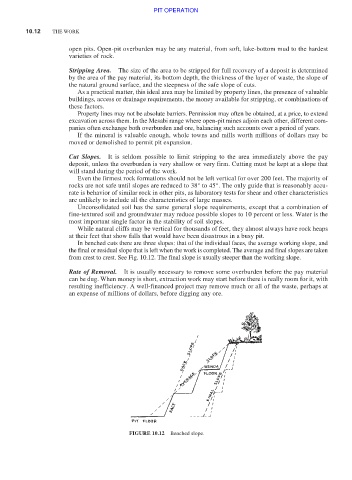Page 506 - Moving the Earth_ The Workbook of Excavation
P. 506
PIT OPERATION
10.12 THE WORK
open pits. Open-pit overburden may be any material, from soft, lake-bottom mud to the hardest
varieties of rock.
Stripping Area. The size of the area to be stripped for full recovery of a deposit is determined
by the area of the pay material, its bottom depth, the thickness of the layer of waste, the slope of
the natural ground surface, and the steepness of the safe slope of cuts.
As a practical matter, this ideal area may be limited by property lines, the presence of valuable
buildings, access or drainage requirements, the money available for stripping, or combinations of
these factors.
Property lines may not be absolute barriers. Permission may often be obtained, at a price, to extend
excavation across them. In the Mesabi range where open-pit mines adjoin each other, different com-
panies often exchange both overburden and ore, balancing such accounts over a period of years.
If the mineral is valuable enough, whole towns and mills worth millions of dollars may be
moved or demolished to permit pit expansion.
Cut Slopes. It is seldom possible to limit stripping to the area immediately above the pay
deposit, unless the overburden is very shallow or very firm. Cutting must be kept at a slope that
will stand during the period of the work.
Even the firmest rock formations should not be left vertical for over 200 feet. The majority of
rocks are not safe until slopes are reduced to 38° to 45°. The only guide that is reasonably accu-
rate is behavior of similar rock in other pits, as laboratory tests for shear and other characteristics
are unlikely to include all the characteristics of large masses.
Unconsolidated soil has the same general slope requirements, except that a combination of
fine-textured soil and groundwater may reduce possible slopes to 10 percent or less. Water is the
most important single factor in the stability of soil slopes.
While natural cliffs may be vertical for thousands of feet, they almost always have rock heaps
at their feet that show falls that would have been disastrous in a busy pit.
In benched cuts there are three slopes: that of the individual faces, the average working slope, and
the final or residual slope that is left when the work is completed. The average and final slopes are taken
from crest to crest. See Fig. 10.12. The final slope is usually steeper than the working slope.
Rate of Removal. It is usually necessary to remove some overburden before the pay material
can be dug. When money is short, extraction work may start before there is really room for it, with
resulting inefficiency. A well-financed project may remove much or all of the waste, perhaps at
an expense of millions of dollars, before digging any ore.
FIGURE 10.12 Benched slope.

